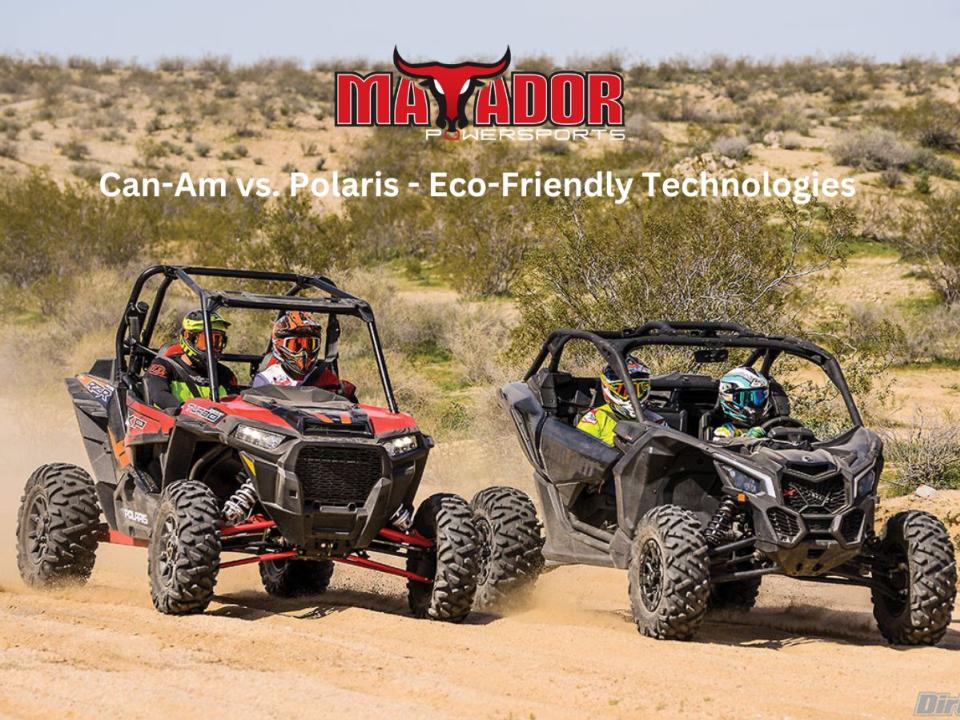When it comes to off-road adventures, two brands stand out: Can-Am vs Polaris. These giants of the ATV (All-Terrain Vehicle) and UTV (Utility Task Vehicle) markets offer a range of vehicles designed for various terrains and activities. Choosing between Can-Am and Polaris can be challenging, as both have strong reputations for performance, durability, and innovation. This guide will delve into the key aspects of both brands to help you make an informed decision.
History and Background
Origins of Can-Am
Can-Am, a division of Bombardier Recreational Products (BRP), was established in 1971. Initially focused on motorcycles, Can-Am shifted its attention to ATVs in the 1990s, quickly gaining a reputation for powerful and reliable off-road vehicles. Over the years, Can-Am has introduced numerous innovations, cementing its position as a leader in the off-road vehicle industry.
Origins of Polaris
Polaris, founded in 1954, began with snowmobiles before expanding into ATVs and UTVs. Known for its pioneering spirit, Polaris has consistently pushed the boundaries of off-road vehicle design and technology. With a focus on innovation and quality, Polaris has become a household name among outdoor enthusiasts.
Product Range
Can-Am Product Line
ATVs: Can-Am offers a diverse range of ATVs designed for different purposes, from recreational riding to heavy-duty utility tasks. Popular models include the Outlander, Renegade, and DS.
UTVs: The Can-Am UTV lineup includes the Maverick, Defender, and Commander. These vehicles are known for their power, versatility, and advanced features, making them suitable for both recreational users and professionals.
Polaris Product Line
ATVs: Polaris’s ATV range is equally impressive, with models like the Sportsman, Scrambler, and Phoenix. These vehicles are built for durability, performance, and adaptability to various terrains.
UTVs: Polaris dominates the UTV market with models such as the RZR, Ranger, and General. These UTVs are celebrated for their innovative designs, robust performance, and user-friendly features.
Design and Build Quality
Can-Am Design Philosophy
Can-Am focuses on combining performance with aesthetic appeal. Their vehicles feature aggressive styling, high-quality materials, and meticulous attention to detail, ensuring both durability and visual appeal.
Polaris Design Philosophy
Polaris prioritizes functionality and practicality. Their vehicles are engineered for rugged performance, with a focus on user comfort and ease of maintenance. Durable materials and robust construction are key aspects of Polaris’s design approach.
Material and Durability Comparison
Both Can-Am and Polaris use high-grade materials to ensure longevity and reliability. Can-Am often integrates advanced composites and reinforced structures, while Polaris emphasizes metal durability and modular construction for easy repairs and upgrades.
Performance and Engine Specifications
Can-Am Performance Metrics
Can-Am vehicles are powered by Rotax engines, known for their impressive horsepower and torque. This makes them suitable for high-speed adventures and heavy-duty tasks. Advanced suspension systems further enhance their performance.
Polaris Performance Metrics
Polaris vehicles feature ProStar engines, renowned for reliability and smooth performance. These engines provide a powerful yet efficient ride, suitable for various off-road conditions. Polaris’s balanced performance approach ensures their vehicles are both fast and durable.
Comparative Analysis
Can-Am often excels in raw power and speed, while Polaris is praised for balanced performance and versatility. Your choice will depend on your specific needs, whether you prioritize speed, handling, or a mix of both.
Off-Road Capabilities
Suspension Systems
Can-Am employs advanced suspension systems like the Torsional Trailing Arm Independent (TTI) rear suspension, providing excellent stability and control. Polaris’s Dual A-arm suspension offers exceptional ground clearance and smooth handling on rough terrains.
Handling and Control
Both brands handle various off-road conditions well, but Can-Am is favored for its aggressive handling and precision control. Polaris is known for stability and ease of maneuverability, making it a reliable choice for all types of riders.
Terrain Adaptability
Can-Am vehicles excel in extreme terrains like dunes and rocky trails, while Polaris models are highly adaptable, performing well on diverse terrains from muddy paths to forest trails.
Comfort and Ergonomics
Seating and Rider Comfort in Can-Am
Can-Am prioritizes rider comfort with ergonomic seating, adjustable handlebars, and spacious footrests. Their UTVs often feature customizable seating arrangements for enhanced comfort during long rides.
Seating and Rider Comfort in Polaris
Polaris designs vehicles with user comfort in mind, featuring cushioned seats, intuitive controls, and ample legroom. Their UTVs offer comfortable seating for passengers, making them ideal for extended use.
Ergonomic Features and Innovations
Both brands incorporate ergonomic designs to reduce rider fatigue. Can-Am focuses on rider-centric innovations like the Ergo-Lok cockpit, while Polaris integrates user-friendly controls and easy-access features.
Technology and Features
Can-Am Technological Innovations
Can-Am leads in off-road technology with features like Intelligent Throttle Control (iTC), Dynamic Power Steering (DPS), and advanced digital displays. Their vehicles are equipped with cutting-edge technology to enhance performance and user experience.
Polaris Technological Innovations
Polaris is known for its Ride Command system, offering GPS navigation, Bluetooth connectivity, and vehicle diagnostics. Other innovations include electronic power steering (EPS) and advanced suspension systems for a smoother ride.
Safety Features Comparison
Both brands prioritize safety with features like roll cages, seat belts, and stability control systems. Can-Am vehicles often include additional safety features like dynamic stability control, while Polaris emphasizes comprehensive safety packages across all models.
Price and Value for Money
Pricing Strategy of Can-Am
Can-Am’s pricing reflects its premium positioning. While their vehicles are more expensive, they offer advanced features and superior performance, providing good value for those seeking high-end off-road vehicles.
Pricing Strategy of Polaris
Polaris offers a range of price points, making their vehicles accessible to a broader audience. Their pricing strategy focuses on providing value through reliable performance and innovative features, ensuring there is a Polaris model for every budget.
Cost vs. Features
Can-Am generally offers more advanced technology and higher performance at a premium price. Polaris, meanwhile, provides a balance of affordability and innovation, appealing to both budget-conscious buyers and those seeking advanced features.
User Experience and Reviews
Can-Am User Feedback
Can-Am users often praise the brand for its powerful performance, stylish designs, and advanced features. Common compliments include the smooth ride and robust build quality, though some users note the higher cost as a drawback.
Polaris User Feedback
Polaris enjoys a strong reputation for reliability, ease of use, and versatile performance. Users frequently commend the brand’s innovative technology and comfortable ride. However, some feedback highlights occasional maintenance issues.
Common Complaints and Praises
Both brands receive high marks for performance and design, but they also face common complaints. Can-Am’s higher price point and complex maintenance needs are often mentioned, while Polaris users sometimes report issues with durability and parts availability.
Maintenance and Reliability
Maintenance Requirements for Can-Am
Can-Am vehicles require regular maintenance to keep them in top condition. This includes routine checks of the engine, suspension, and electrical systems. While maintenance can be more intensive, it ensures long-term reliability and performance.
Maintenance Requirements for Polaris
Polaris vehicles are designed for ease of maintenance, with accessible components and clear maintenance guidelines. Regular servicing is essential, but the brand’s focus on user-friendly design simplifies the process.
Long-term Reliability
Both Can-Am and Polaris are known for their long-term reliability when properly maintained. Can-Am’s robust construction and high-quality materials contribute to its durability, while Polaris’s emphasis on dependable performance ensures their vehicles withstand the test of time.
Resale Value
Can-Am Resale Trends
Can-Am vehicles tend to retain their value well, thanks to their high performance and premium features. The brand’s strong reputation and loyal customer base also contribute to healthy resale values.
Polaris Resale Trends
Polaris vehicles also enjoy good resale value, particularly models with advanced features and low mileage. The brand’s widespread popularity and extensive dealer network support strong resale prices.
Factors Affecting Resale Value
Several factors influence resale value, including model year, condition, mileage, and market demand. Both Can-Am and Polaris benefit from their respective brand reputations and the quality of their vehicles, ensuring strong resale prospects.
Brand Loyalty and Community
Can-Am Enthusiast Communities
Can-Am has a dedicated and passionate community of enthusiasts. Online forums, social media groups, and organized events foster a strong sense of camaraderie among Can-Am owners, who share tips, experiences, and support.
Polaris Enthusiast Communities
Polaris boasts a large and active community of fans and owners. The brand’s extensive network of clubs, events, and online platforms provides a rich environment for sharing knowledge, organizing rides, and celebrating the Polaris life>
Brand Loyalty Insights
Both Can-Am and Polaris enjoy significant brand loyalty. Customers often stick with their preferred brand due to positive experiences, reliable performance, and strong community support. This loyalty is a testament to the quality and appeal of both brands.
Environmental Impact
Can-Am’s Environmental Policies
Can-Am is committed to reducing its environmental footprint through sustainable manufacturing practices and the development of eco-friendly technologies. The brand’s efforts include improving fuel efficiency and reducing emissions in their vehicles.
Polaris’s Environmental Policies
Polaris also prioritizes environmental sustainability, focusing on reducing emissions and improving fuel efficiency. The company invests in research and development to create greener technologies and minimize the environmental impact of its products.
Eco-friendly Models and Initiatives
Both brands are exploring eco-friendly initiatives, such as electric and hybrid models. Can-Am’s focus on innovative technologies and Polaris’s commitment to sustainability ensure that both companies are contributing to a greener future.
Conclusion
In the battle of Can-Am vs Polaris, both brands offer exceptional off-road vehicles that cater to a wide range of needs and preferences. Can-Am stands out for its powerful performance and advanced features, while Polaris is celebrated for its versatility and user-friendly designs. Ultimately, the choice between the two comes down to personal preference, specific requirements, and budget considerations. Both Can-Am and Polaris deliver on their promises of quality, reliability, and an exhilarating off-road experience.
FAQs
Which brand is better for beginners?
Polaris is often considered more beginner-friendly due to its user-friendly designs and ease of maintenance. However, Can-Am also offers models suitable for newcomers, particularly those looking for high performance.
Are Can-Am and Polaris parts interchangeable?
Generally, Can-Am and Polaris parts are not interchangeable due to differences in design and engineering. It’s best to use brand-specific parts to ensure compatibility and performance.
Which brand offers better customer support?
Both Can-Am and Polaris provide excellent customer support through their extensive dealer networks and customer service channels. Polaris may have a slight edge due to its larger market presence.
How do Can-Am and Polaris compare in terms of fuel efficiency?
Fuel efficiency varies by model, but both brands have made strides in improving fuel economy. Polaris generally offers slightly better fuel efficiency across its range, though Can-Am’s advanced engines also deliver respectable mileage.
What are the warranty options for Can-Am and Polaris?
Both brands offer comprehensive warranty options. Can-Am typically provides a standard six-month warranty, with extended coverage available. Polaris offers a similar warranty period, with options for extended protection plans.
Created by: Zac Efron










